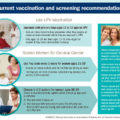What is HPV?
Human papillomavirus (HPV) is a viral infection that is passed between people through skin-to-skin contact. According to the World Health Organization, the Human papillomavirus is the most common viral infection of the reproductive tract. Most sexually active women and men will be infected at some point in their lives and some may be repeatedly infected.
The peak time for acquiring infection for both women and men is shortly after becoming sexually active. HPV is sexually transmitted, but penetrative sex is not required for transmission. Skin-to-skin genital contact is a well-recognized mode of transmission.
There are many types of HPV, and many do not cause problems. HPV infections usually clear up without any intervention within a few months after acquisition, and about 90% clear within 2 years. A small proportion of infections with certain types of HPV can persist and progress to cervical cancer.
Cervical cancer is by far the most common HPV-related disease. Nearly all cases of cervical cancer can be attributable to HPV infection.
The infection with certain HPV types also causes a proportion of cancers of the anus, vulva, vagina, penis and oropharynx, which are preventable using similar primary prevention strategies as those for cervical cancer.
Non-cancer causing types of HPV (especially types 6 and 11) can cause genital warts and respiratory papillomatosis (a disease in which tumours grow in the air passages leading from the nose and mouth into the lungs). Although these conditions very rarely result in death, they may cause significant occurrence of disease. Genital warts are very common, highly infectious and affect sexual life.
How HPV infection leads to cervical cancer
Although most HPV infections clear up on their own and most pre-cancerous lesions resolve spontaneously, there is a risk for all women that HPV infection may become chronic and pre-cancerous lesions progress to invasive cervical cancer.
It takes 15 to 20 years for cervical cancer to develop in women with normal immune systems. It can take only 5 to 10 years in women with weakened immune systems, such as those with untreated HIV infection.
Risk factors for HPV persistence and development of cervical cancer
- HPV type – its oncogenicity or cancer-causing strength;
- immune status – people who are immunocompromized, such as those living with HIV, are more likely to have persistent HPV infections and a more rapid progression to pre-cancer and cancer;
- coinfection with other sexually transmitted agents, such as those that cause herpes simplex, chlamydia and gonorrhoea;
- parity (number of babies born) and young age at first birth;
- tobacco smoking
Can a woman give a man HPV?
Yes, many men who contract an HPV infection have no symptoms, although some may develop genital warts. See your doctor if you notice any unusual bumps or lesions on your penis, scrotum, or anus.
Some strains of HPV can cause penile, anal, and throat cancer in men. Some men may be more at risk for developing HPV-related cancers, including men who receive anal sex and men with a weakened immune system. The diagnosis of HPV in men is made when external genital warts are seen.
Since there is no treatment for HPV that has no symptoms, most men with the infection are not treated. Sometimes, a healthcare provider can see small warts that might have otherwise gone unnoticed. In general, HPV infection does not place a man at a much higher risk for health problems. However, HPV prevention is still important for men, as the virus has been linked to uncommon cancers such as penile, anal, and head and neck cancer.
Can HPV infections be prevented?
Since HPV is so common, even those who have only had one partner can still get the virus. Using condoms correctly each time you have sex reduces the risk of getting sexually transmitted infections, and might offer some protection against HPV. Keep in mind that skin in the anal/genital area not covered by a condom can still be affected.
The best prevention is the HPV vaccine. It can prevent both high-risk and low-risk HPV and is recommended for boys and young men (along with girls and young women).
How are men tested for HPV?
Men are typically screened clinically with a visual inspection to check for lesions (such as warts) – there is no specific way to test directly for HPV in men that is approved for clinical use. Researchers are looking at ways to better screen men, but the current lack of testing options for males can be very frustrating.
While still not routinely done, anyone with a history of receptive anal sex may want to speak with his or her health care provider about having an anal Pap test. Anal cancer is uncommon, but screening can still be an important precaution – talk to your provider if you have questions.
What about partners?
Most sexually active couples share HPV until the immune response suppresses the infection. Partners who are sexually intimate only with each other are not likely to pass the same virus back and forth. When HPV infection goes away, the immune system will remember that HPV type and keep a new infection of the same HPV type from occurring again. However, because there are many different types of HPV, becoming immune to one HPV type may not protect you from getting HPV again if exposed to another HPV type.
Can a man be tested?
Research has shown that the HPV test may lead to inconsistent results with men. This is because it is difficult to get a good cell sample to test from the thick skin on the penis. Most people will not have visible symptoms if they are exposed to HPV. Therefore, for most, the virus is subclinical (invisible). This is especially true for males. If a male is exposed to the cell-changing types of HPV, he would be unlikely to have symptoms. If there are no symptoms for males, it is hard to test for it. Most of the time, men will not have any health risks such as cancer with the “high-risk” types of HPV. It is the female’s cervix that needs to be monitored.






